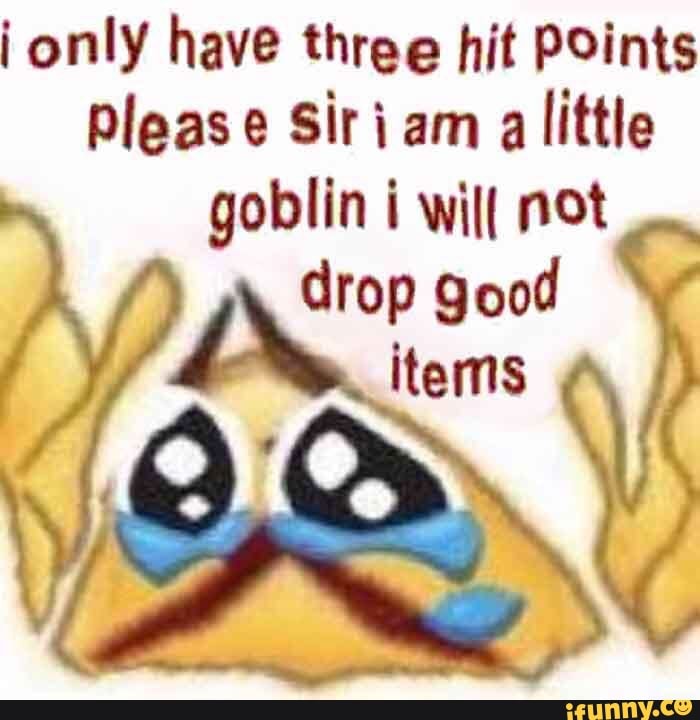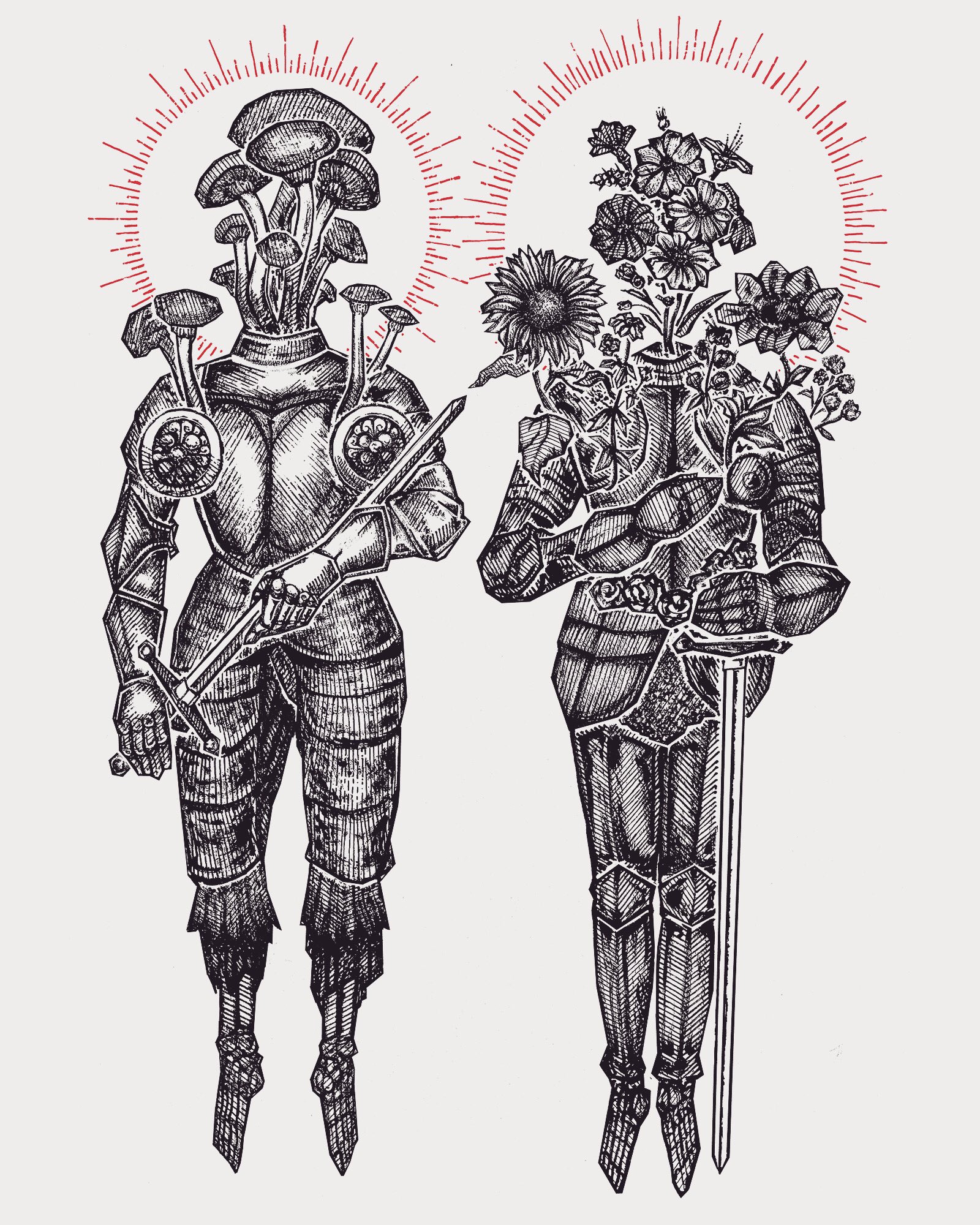Work continues on the Dark Souls/Arthurian combat minigame! Today’s notes - enemies.
Before we start… I still haven’t named this thing. Going off the ~lore~ established in the last post, I’m going to to throw some ideas out off the top of my head as I write this and see what sticks uuuuuhhh… Chivalry Is Dead? Too on the nose maybe. Excaliburied. Ha. The Dolorous Stroke, of course, is already taken by Emmy Allen’s wargame for which it is perfect. Could just call it Overkill, but that sounds a bit too Heavy Metal to me. Onslaught? That’s just a word I like, but I don’t think it fits.
I don’t know, still thinking. Answers on a postcard. I’ll keep tagging these as The Green Knight for now, i guess.
Right! Let’s make a foe.
 |
| from Dark Cloud, on the Influences list |
I think there’s just about enough of the mechanics in place that the easiest way I can think of designing an enemy is to imagine what a finished one will look like. I’m thinking the smallest of statblocks - a card or something, mostly art, with a name and a quotation that they might say before battle. That seems quite Dark Souls.
Then, mechanically, we need to know what they do on their “turn”, every time your dial passes 13, and how the Overkill concept factors into that action. (It might not at all - but so far that’s the only thread of an idea I have so I’m sticking with it.)
Anything else? Some loot you get if you win, their weapon or helmet maybe. Any other additionally info can wait for a more fleshed-out version of the game.
Ok, first step - going back to the ~lore~ and coming up with a character concept that fits! This is going to be a standalone enemy for our playtest battle, so I’d rather not think about castle layouts or anything just yet. This is going to be an open, standalone fight with a clear goal and an Implied world around it, but not much actual detail or complication. Something that gets across the potential of the larger world in one scene.
Here’s what I have right now:
Bridgekeeper Kalidor
“None pass hence that live. Have at thee!”
art: relatively normal knight with some plants growing through the armour in places. Male/ambiguous. Sword probably as weapon, emblem on shield of first “boss” Lord? Idk. Maybe his helm is lifted to reveal a skull.
And that’s just about all we need on that front. Normal, kinda boring first enemy - but sometimes you need a bit of boring before shit hits the fan later. Now for the actual work…
This doofus needs to teach the very basics of the game, not in terms of the rules but more what strategies and ways of playing are useful. Which as far as we know are: Calculate your risks, try to pass 13 with a low roll or some kind of defensive effect, overkill is bad.
So he has one big, obvious, slow attack that doesn’t really need any fancy effects. Like a training dummy, kinda. This will also help form something of a base to think of some future enemies from.
Also -what *can’t* we make a feature of this guy? Well as it stands the way to win fights is always the same, rack up hits and then try to finish them off when you think you’ve done enough. This means that we can’t really make fights longer or shorter, or give guys more “health”, without adding complications to the basic mechanics - and complications are not what this fight is about.
So how long will the fight take? Well, 2d6 averages at 7, call it 6 if we’re lucky. Let’s say you get 1 or 2 hits in a turn, maybe 3. That’s somewhere between 3-6 turns of combat before you can even start to reasonably think about risking your turns on the kill shot. Most likely more, and accounting for bad luck I’d say 9 turns is a decent rough estimate for now.
That’s… quite long? Turns should whip by once you know what you’re doing, but this is the first fight and we’re learning. Something to bear in mind, I guess.
Having said all that, if the action options and choices presented by the luck of the dice are engaging enough, this all shouldn’t matter too much or feel like a slog. Actually, it feels about right to me? But that’s all stuff governed by the player’s actions and items, which we haven’t really got to yet.
For now, let’s work out how we can make those 9-ish turns engaging using our enemy.
 |
| The “Duel” in question |
First question: does he just do the one attack every turn? It won’t feel exactly the same because overkill will factor in there somehow, but over 9 turns that novelty might not sustain if the flavour is really just going to be “swings sword”. So we need some variance in behaviour.
We also need to get across to the player when is roughly the right time to start attempting the kill shot. So, two birds - let’s say that after you’ve dealt 7 hits to Kalidor he changes his action up in some way? This might have the opposite though and make players want to *not* rack up that many hits, since don’t forget this is a solo game and they can see all these rules and variances laid out. In that case, let’s call it 9 hits - plenty of space, and it can be comfortably avoided. If at worst case you’re landing a hit a turn, and still slogging away after 9 turns, it’s time to wrap up.
So what does this guy do when you’ve hit him 9 times? Better work out what he does normally first!
(Ah, the enemy action, the hole in the middle of this doughnut that’s been staring at me for so long now… What to do with you…)
For now, I’m going with Overkill = damage. A few reasons - mainly I did a very rough test and it felt easy to play. And since this is an introductory fight, what better way to get across the concept of overkill than making it literally the only danger you need to focus on? No additional maths or effects yet, just “look at the number”. Sometimes - often, I find - the best mechanic is the one that seems the easiest to wrap your head around. A good mechanic that’s hard to explain isn’t a good mechanic at all.
I know I said just one attack would be boring, and I’ll get to that. But the main thing is OK=dmg is an effective base for other things, bonuses and whatnot. There are all kinds of ways to make it more complex and add extra mechanics onto that base, like the “threshold” thing I mentioned in a previous post.
Speaking of - that idea of 9 hits being a threshold for some kind of change-up? It occurred to me that since 9 is the 3/4 mark on a standard clock, if we were to make this a normal 12-hour clock instead of 13 we could demarcate quadrants as “zones” indicating different behaviours. Four “seasons” with different effects or enemy behaviours as you rack up hits and the token moves around.
Then just make the 2d6 finishing blow a “roll equal or under” rather than just roll under, and we don’t really need that 13. It’ll make turns a little more scary and short, too. A 6 is now exactly half your turn gone, there’s no buffer.
Ok so Overkill is base damage, and different “seasons” can add or change that as the enemy takes more hits. Good enough for now!
So, uh… what’s damage?
 |
| sorry |
We need to know about player health to know what damage means. I had a pretty simple idea for this during that little scratch play test fight, and it seems to work ok so I’m sticking with it.
The token that now moves around the rondel (better name than dial?) is now another d6. Starting on 6 and ticking down - that’s your health. I like that it represents “you” on the “board”, and it’s a simple way of tracking that eschews note-taking. Most Overkill hits are just 1 or 2 due to a bad or misjudged roll, and a 3 or 4 feels suitably devastating and Dark Souls-y. Nobody would risk more than that anyway, you’d have to deliberately make a bad decision to take any more damage in a single hit. Or, the enemy would need bonuses hehe.
And, there’s still a token on the dial for keeping track of your hits on the foe. Easy to differentiate between the two now that one’s a die.
So - bonuses! To stick with the initial idea of teaching when’s best to deliver the kill shot, I’m deciding that for now our Bridgekeeper deals base damage from 0-8 hits and gets a +1 bonus on 9+. So spring to autumn you’re relatively safe, but winter is coming. That should make it clear how you’re “meant” to approach the puzzle but still give leeway.
The other thing that became clear in my play test is that defensive actions felt a bit bland. I was trialling a “heavy” roll to attack and a “light” to defend (see the first post in this series) as my only two options, and that felt good, but a “failed” defend roll - i.e, one that didn’t push you past 13 and start the next turn - just felt like a fizzle rather than an interesting failure. My idea to fix this, which came from an earlier iteration of the mechanic from way back in my notebook, is that a “failed” defend roll actually reduces the current number of hits on the enemy. So they’re not literal hits, more like your current combat advantage - but basically flinching when you didn’t need to makes you lose a bit of momentum. Even more incentive to take silly risks!
Oh, and as for what defensive actions *do* when they succeed, I’m thinking -1 damage is good enough for this fight. I’m not too keen on all these numbers, but it’s fitting for the type of game this is. I wouldn’t put them in a straight RPG. I’ll need to test this though, it might not feel powerful enough.
(Of course, actions are tied to items, and there may be other shields or items that do other things…)
All in all these changes make the basics of the game feel solid. I feel like you could almost play this fight as-is now, but there are just one or two things I want to iron out first around items and player actions.
Next post I’ll sort that out, and then we’ll have a “tutorial” fight ready to play!












